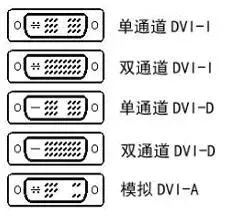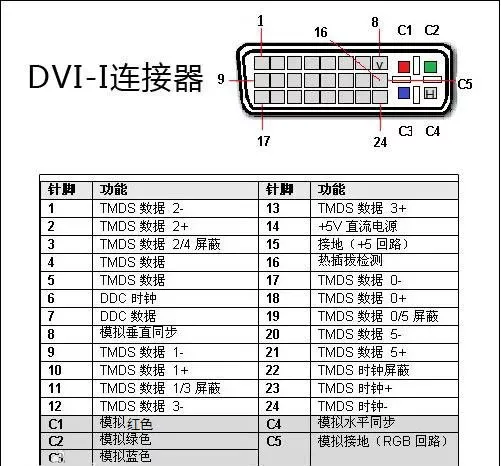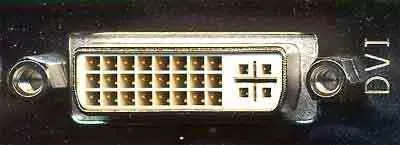
DVI stands for "Digital Visual Interface", which means "Digital Video Interface" in Chinese. It is a video interface standard designed to transmit uncompressed digital video. There are 3 types and 5 specifications of DVI interfaces. The 3 major categories include DVI-A interface, DVI-D interface, and DVI-I interface. The 5 specifications include DVI-A, single-connection DVI-D, dual-connection DVI-D, Single connection DVI-I, dual connection DVI-I.

The operating environment of this tutorial: Windows 7 system, Dell G3 computer.
The full English name of DVI is Digital Visual Interface, and the Chinese name is "Digital Video Interface".
DVI is a video interface standard designed to transmit uncompressed digital video. Widely used in display devices such as LCDs and digital projectors. This standard was developed by the Digital Display Working Group (DDWG), a forum composed of several leading manufacturers in the display industry. The DVI interface can send uncompressed digital video data to the display device. This specification is partially compatible with the HDMI standard.
The DVI interface was first initiated in 1999 by industry giants such as Silicon Image, Intel, Compaq, IBM, HP, NEC, and Fujitsu. They formed DDWG (Digital Display Working Group, Digital Display Working Group) later launched this interface standard.

Specifications of DVI interface
DVI interface has 3 types and 5 specifications, of which the 3 major categories include: DVI-Analog (DVI-A) interface, DVI-Digital (DVI-D) interface, DVI-Integrated (DVI-I) interface, 5 specifications including DVI-A (12 5), single connection DVI-D (18 1), dual Connects DVI-D (24 1), single link DVI-I (18 5), dual link DVI-I (24 5).


DVI-Analog (DVI-A) interface (12 5) only transmits analog signals, which is essentially the VGA analog transmission interface specification. When you want to connect the analog signal D-Sub connector to the DVI-I socket of the graphics card, you must use a conversion connector. The plug that the adapter connects to the graphics card is the DVI-A interface. This type of plug can also be seen in early large-screen professional CRTs.
DVI-Digital (DVI-D) interface (18 1 and 24 1) is a purely digital interface that can only transmit digital signals and is not compatible with analog signals. Therefore, DVI-D sockets have 18 or 24 digital pin jacks and 1 flat jack.
DVI-Integrated (DVI-I) interface (18 5 and 24 5) is compatible with digital and analog interfaces, so the DVI-I socket has 18 or 24 digital pins. 5 analog pin jacks (the four-pin hole and a cross flower next to it). The 4 extra lines than DVI-D are used to be compatible with traditional VGA analog signals. Based on this structure, the DVI-I socket can be plugged into DVI-I and DVI-D plugs, while the DVI-D socket can only be plugged into DVI-D plugs. DVI-I compatible analog interface does not mean that the analog signal interface D-Sub plug can be directly connected to the DVI-I socket. It must be connected through a conversion connector. Generally, graphics cards using this interface will have related conversion connectors. Considering compatibility issues, graphics cards generally use a DVI-I interface, which can be connected to an ordinary VGA interface through a conversion connector. Monitors with two DVI interfaces generally use the DVI-D type. For monitors with a DVI interface and a VGA interface, the DVI interface generally uses a DVI-I interface with analog signals.
Maximum resolution |
|
Interface type |
Maximum resolution |
VGA |
2048x1536,60Hz |
DVI-I single channel |
1920x1200,60Hz |
DVI-I dual channel |
2560x1600,60Hz/1920x1080,120Hz |
| DVI-D Single Channel
|
##1920x1200,60Hz |
2560x1600,60Hz/1920x1080,120Hz |
| Type | Signal type | Number of pins |
Remarks |
| DVI-I Single Channel | Digital/Analog | 18 5 | Convertible VGA |
| DVI-I dual channel | Digital/Analog | 24 5 | Convertible VGA |
| DVI-D Single Channel | Digital | 18 1 | Non-ConvertibleVGA |
| Digital | 24 1 | Not convertible to VGA | |
| Simulation | 12 5 | Deprecated |
Comparison of advantages and disadvantages
| Advantages | Disadvantages | Suggestions | ##VGA |
Supports resolutions up to 2048x1536, |
is susceptible to interference from other signals, the fonts are a bit blurry at high resolutions, and does not support hot swapping |
To prevent the picture from being easily disturbed, use VGA at 1920x1080 resolution and within 20 inches. |
DVI |
The picture at high resolution is more delicate and less susceptible to signal interference | There are many types, and most DVI cables do not support resolutions above 1920x1200. Hot swapping may burn out the circuit |
It is recommended to use DVI for full HD monitors. If the resolution exceeds 1920x1200 or 3D is used, a dual-channel cable is required. |
For more related knowledge, please visit the |
The above is the detailed content of What does dvi mean?. For more information, please follow other related articles on the PHP Chinese website!
 Vue parent component calls the method of child component
Vue parent component calls the method of child component
 What is digital currency trading
What is digital currency trading
 How to use fusioncharts.js
How to use fusioncharts.js
 length function usage
length function usage
 Cost-effectiveness analysis of learning python, java and c++
Cost-effectiveness analysis of learning python, java and c++
 Representation method of string constant
Representation method of string constant
 mysql transaction isolation level
mysql transaction isolation level
 How to open .dat files
How to open .dat files
 how to build a website
how to build a website




